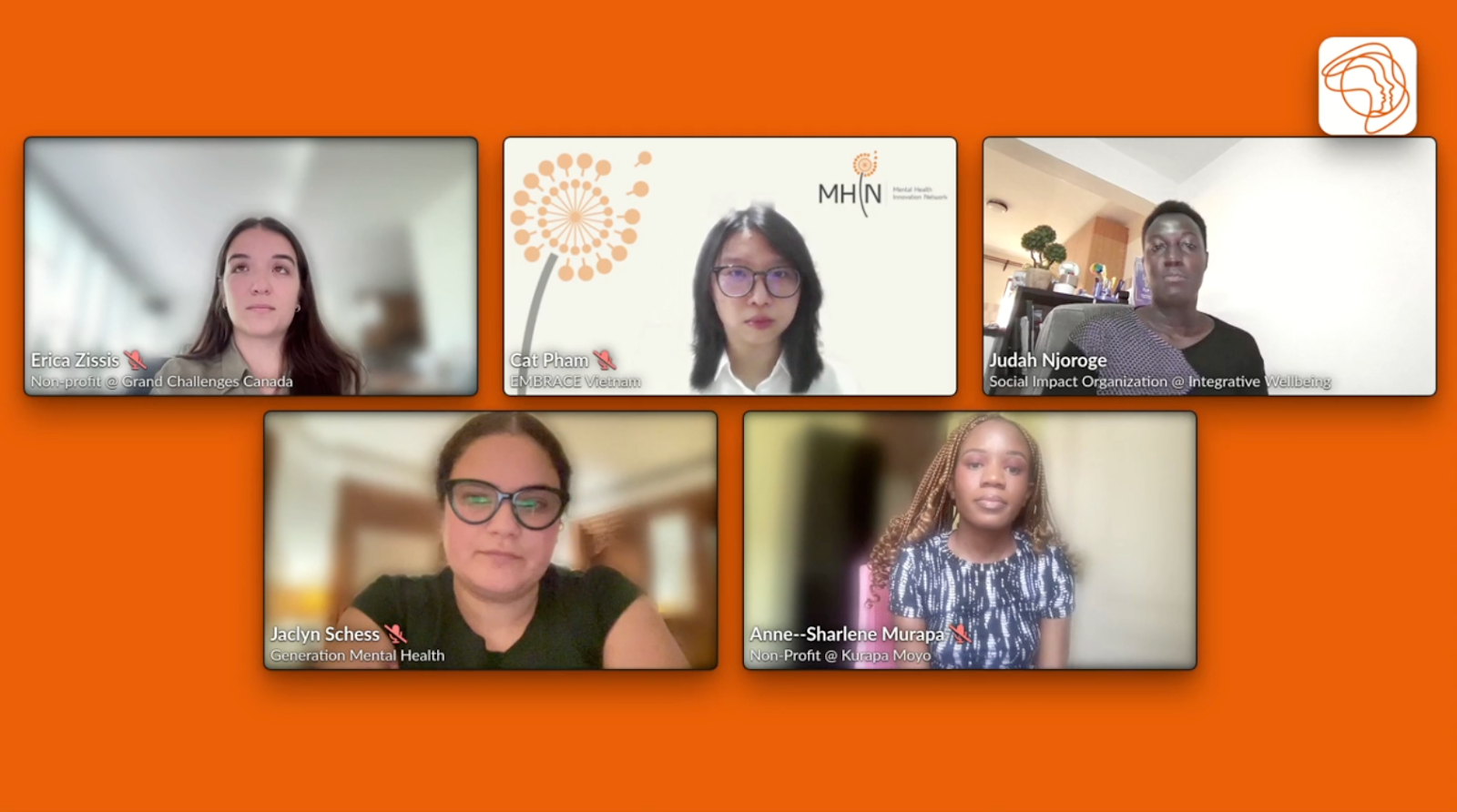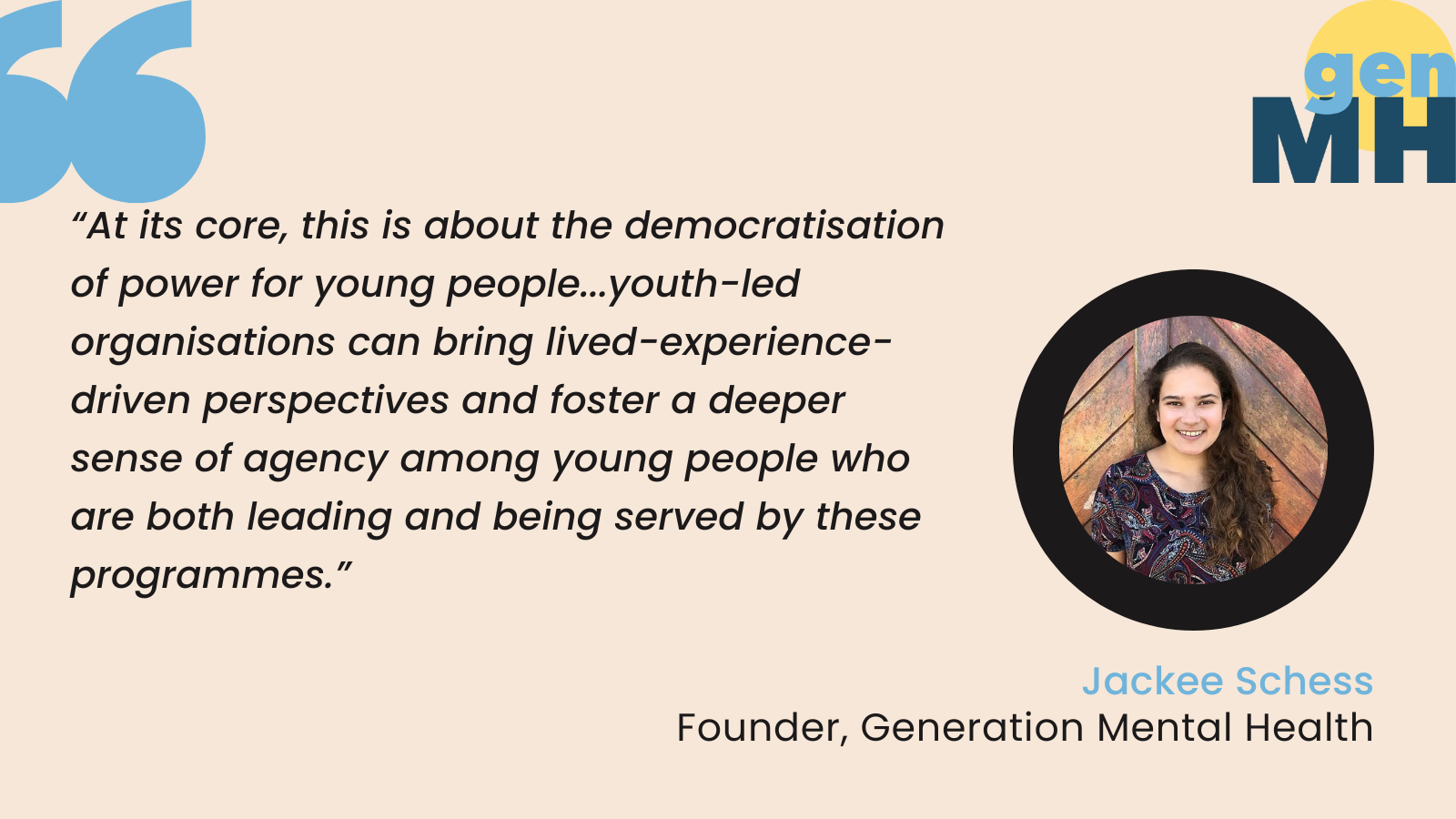Youth Reimagining Leadership in Mental Health: Event Report
Youth mental health interventions are most effective when they recognise young people as collaborators and change agents in shaping the very systems that impact them. More insights from the Global Mental Health Action Network's July panel.

When we think about young people in the mental health space, the conversation often begins with how to design programmes that support their wellbeing. Youth mental health interventions are most effective when they recognise young people as collaborators and change agents in shaping the very systems that impact them. They are not only recipients of support but also experts with lived experience, whose insights are rooted in navigating the realities of today’s world. They bring invaluable knowledge of what works, what doesn’t, and what still needs to be imagined.
At the heart of this is the idea that young people should have a voice in the future they will inherit. While this principle is increasingly echoed across institutions and policies, its implementation is far from straightforward. Youth leadership must be intentionally fostered and redefined in the context of mental health, where leading might look softer, slower, more care-driven. It must move beyond buzzwords to create space for young people to shape systems with authenticity, equity, and sustained impact.
To foster dialogue on this, the Global Mental Health Action Network organised a panel discussion on “Youth Reimagining Leadership in Mental Health” on 22 July 2025 as part of their Mental Health for All Webinar Series.
Panellists included
Erica Zissis (Grand Challenges Canada | Being Initiative), Jaclyn Schess (Generation Mental Health),
Cat Pham
(EMBRACE Vietnam), and
Anne--Sharlene Murapa (Kurapa Moyo).
Judah Njoroge of Integrative Wellbeing moderated the session.
Njoroge prompted the panellists to consider the idea of youth being at the forefront of change in the mental health landscape and implored them to share what it looks like in their respective contexts. Anne--Sharlene Murapa, from Kurapa Moyo, kicked off the conversation with a compelling demonstration of young people’s agency, “It means not waiting for permission. As young people, we tend to wait for others to co-sign our ability to take action.” In a world where youth are at the forefront of change, they tell themselves, in the words of Murapa, “I have the capacity and mindset to ideate a solution and identify people I can work with to implement it.”
We think of leadership as being on the forefront, but it is also so much about co-creation, she explained.
Cat Pham from EMBRACE Vietnam likened the ecosystem of mental health advocacy to a board game that offers you alternatives to lead different life courses. She explained, “There are so many ways you can navigate the mental health space, so many ways you can contribute and engage with others in the field: you could be an educator, a trainer, a project lead, a policymaker trying to make mental healthcare more accessible.” Ultimately, according to Pham, what matters is that you can contribute meaningfully to the space, making a fruitful addition to the broader context.
From among those based in the Global North, Erica Zissis from Grand Challenges Canada | Being Initiative, shared the funder perspective on this:
“Our core belief is that people closest to the issues are best placed to identify these challenges and needs and come up with impactful solutions.” Acknowledging young people as drivers of change, Zissis emphasises that finding and supporting research and innovation led by youth is a funding priority. As a resource, she shared
Being's New Report: Youth Voices — A Guide to Meaningful Youth Engagement in Mental Health Funding.
Jaclyn Schess, founder of Generation Mental Health, brought in the perspective of a youth-led organisation, “Generation Mental Health is uniquely positioned in that we are a youth-led organisation that is also seeking to support other youth-led organisations. In acquiescence that young people are often the best sources of insight, both in identifying what supports their mental health and in naming the challenges they face in leadership roles, Generation Mental Health has made a conscious effort to nurture a space that will shape youth leadership within the organisation itself.”
“At its core”, Schess shares, “this is about the democratisation of power for young people. While non-youth-led organisations can and should support this work, youth-led organisations can bring lived-experience-driven perspectives and foster a deeper sense of agency among young people who are both leading and being served by these programmes.”

In the next segment, the panellists reflected on how they entered the mental health space and the barriers they encountered in stepping into leadership roles.
Pham offered a peek into Vietnam’s fledgling mental health space. She acknowledged the privilege of being able to start a mental health project, but underscored the difficulty of sustaining it: balancing school with unfunded work, and operating in a sector with no clear roadmap. “We’re figuring things out as we go,” she said, adding that the future of a clearer mental health ecosystem in Vietnam could offer more defined opportunities for youth engagement. A key challenge for her remains ensuring meaningful representation from marginalised communities in the design of local solutions.
Murapa shared that while passion drives the work, “mental health support is so underfunded that we’re constantly being stretched in ways we didn’t think possible.” She spoke of leaning into community and indigenous knowledge, but also the ongoing effort to protect her own wellbeing: “Just because I’m a mental health activist doesn’t mean my mental health isn’t important.”
Schess shared, “At the forefront was my own experience with mental health challenges, which started at a very young age.” What proved most impactful for her was accessing peer-led support at university, which shaped her recovery and sparked a sense of agency. “Being involved in advocacy and systems change can be really helpful for your mental health journey,” she noted, while also highlighting the challenge of entering formal organisational spaces where young people may be heard but rarely included in actual decision-making. “It’s not just about opening the door—it’s about giving them a seat at the table.”
This offered a robust segue for the conversation to explore how identity shapes how young people claim space.
Zissis noted that our lived experience expertise is being sought after by advisors and innovators. Our identity shapes and influences our perception, and that isn’t necessarily a limiting thing; leaning into our lived experience can be powerful.
“Claim space not despite but because of who you are,” she implored. Schess pointed out something she has learnt through the years of training young changemakers who, in turn, help other young changemakers on the ground, “Young people are not a monolith, and you can't have a young person speak for or be a spokesperson for millions of young people.”
She also explained that youth organisations can offer a model for supportive processes, “In a lot of youth organisations, it is normal to have a conversation about taking a step back when your mental health is not at its best. Perhaps other organisations can learn how we relay such things. Capacity strengthening will be key so people feel comfortable to be able to speak in those environments.”
Pham had earlier in the conversation mentioned the very real challenge of including representation for young people with various identities. And while the panel agreed that it is hard to answer this universally — contexts differ and so do the definitions and scopes of diversity and identity labels — they offered a perspective shift to enable more spaces for young people, without worrying about scale. Murapa talked about how community gatherings can help address collective experiences of intergenerational trauma in a shared space. She also emphasised that solutions to mental health challenges don’t have to look a certain way.
Pham provided examples from the Vietnamese context, “Appreciating diversity isn’t hard. It starts with humility about what you know and a curiosity to learn. In my context, age is a constant undercurrent: people often ask how old you are mid-discussion, which is strange but also telling. Being young can be both a benefit as well a disadvantage. Policymakers are listening to youth, but it can’t be a monologue led by a small council. We represent only part of the picture.”
Burnout in activism is a well-documented reality, especially for those working at the intersections of lived experience and systemic change. The emotional toll of constantly showing up for a cause, for a community, for others, can make it difficult to pause and care for oneself.
Which brought us to the moderator’s final prompt, “How do you hold space for your well-being and balance it with showing up for others?”
Murapa, who had previously hinted at valuing her mental health, shared her practical approach with affirming conviction, “I reference the work we do and look at intention and care as our values. We don’t do any work we do, to the detriment of ourselves.”
She added, “It’s very important not to burden yourself with the need to solve everything. Trust that other people are going to step up and do the work, too.”
Echoing the sentiment, Schess agreed that collaboration and teamwork are the way to go,
“At the end of the day, what helps me sustain is my team that I rely on. We are all working to reach the North Star together, and we can't get there if we are all burned out. It is very important to create an environment where we can ask each other for help, and also go out into the broader ecosystem and ask for help.”
Zissis advised not to get burdened by the expectations put on someone in a leadership position to be perfect: “You can lead while also being transparent about learning and asking questions. Show up better as a leader by prioritising your mental wellbeing.”
Pham added, “As young leaders, we should collaborate with those more experienced than us as well. I strongly believe that they want to help us, and we should reach out and open this space for both of us.”
GenMH will soon launch a virtual Mental Health Policy Advocacy Toolkit. This is a self-paced walk-through of advocacy principles and practices, sharing lived experience perspectives, planning and evaluating advocacy initiatives and more! It was developed in partnership with Orygen, utilising materials and learnings from their Global Youth Mental Health Advocacy Fellowship, with funding from the UC Berkeley Social Impact Fund. This information is based on consultations with youth advocates worldwide. To stay up to date and receive updates when the toolkit launches later this year, sign up for our newsletter at
genmh.org/contact or follow us on social media!


